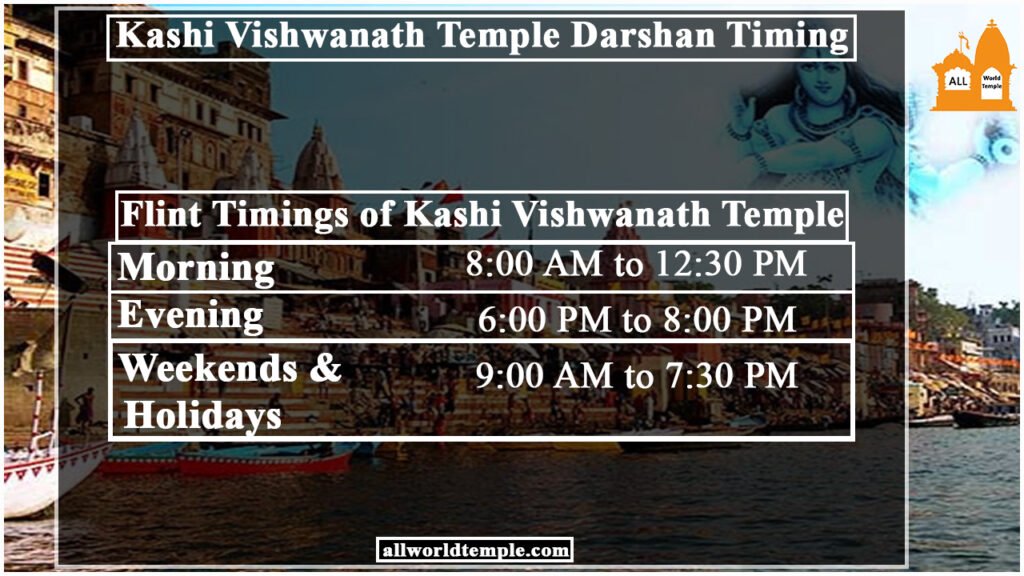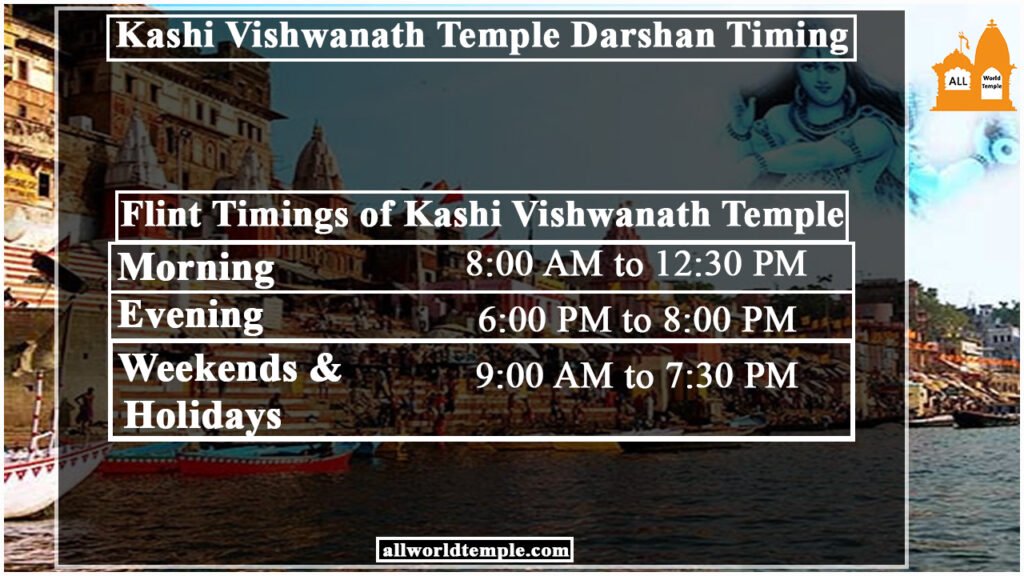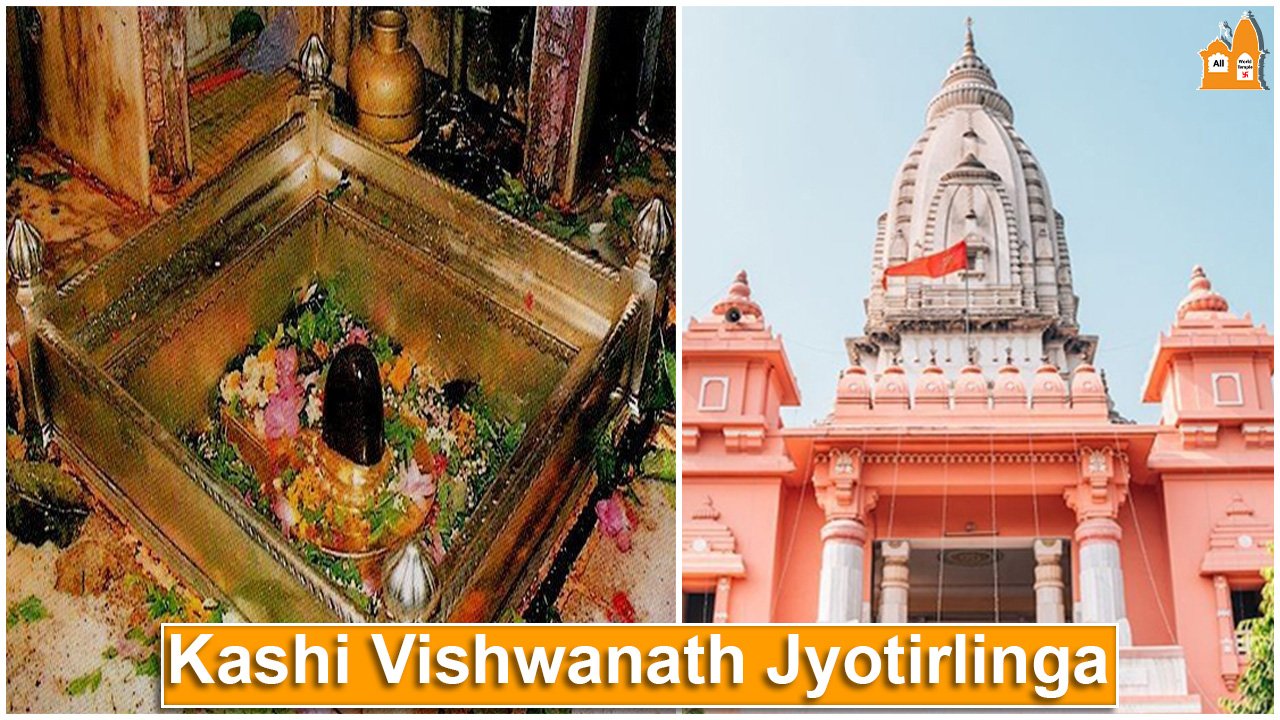Important information
- Location: Lahori Tola, Varanasi, Uttar Pradesh 221001
- Festivals: Shivratri For Other Festival Details Click here
- Main Deity: Lord Shiv Click here
- Languages: English & Hindi
- Darshan Timings: 03.00 am to 11:00 pm
- Best Season To Visit: October to March is the best time to visit
- Kashi Vishwanath Temple Contact Number: 05422392629 | +916393131608
- How To Reach
- Note: Mobile, cameras & electronic equipment are not allowed on temple premises.
Kashi Vishvanath Temple is one of the most famous and beautiful Hindu temples dedicated to Lord Shiva. The temple is located in Varanasi, Uttar Pradesh, India. The temple stands on the western bank of the holy river Ganga, and it is one of the twelve Jyotirlingas, It is the holiest temple of Shiva. The main deity is known by the name Vishvanatha or Vishveshvara meaning Ruler of The Universe. Varanasi city is also called Kashi, and hence the temple is popularly called the Kashi Vishvanath Temple. The temple is one of the main temples of Varanasi. It is believed the first rays of the sun fall on the temple.
The Many leading saints of India, including the Adi Sankaracharya, Ramakrishna Paramhansa, Swami Vivekananda, Bamakhyapa, Goswami Tulsidas, Swami Dayananda Saraswati, Sathya Sai Baba, and Gurunanak have visited this Temple. A visit to the temple and take a bath in the river Ganges is one of many methods believed to lead one on a path to Moksha (liberation). Thus, Hindus from all over the world try to visit the place at least once in their lifetime. Just Because of the immense popularity and holiness of the Kashi Vishwanath temple, hundreds of temples across India have been built in the same architectural style.

History
According to evidence, the history of the Kashi Vishwanath Temple dates back to the 11th century. The Temple was subjected to repeated intrusions and damage. The first structure of the temple was damaged by Qutb-ud-din-Aibak in 1194 CE however was reconstructed under the reign of Sultan Iltutmish.
The Kashi Vishwanath Temple was again damaged under the reign of either Sikander Lodhi or under Husain Sharqi in the 1400s. Raja Man Singh constructed it however was boycotted as he allowed the Mughals to get married into his family. Todar Mal even further rebuilt the Temple with Akbar’s true blessings at the original site in 1585.
In 1669, Aurangzeb damaged the temple again and over the structures, constructed the Gyanvapi Mosque. Later on, plans were made to destroy the mosque by Maratha ruler Malhar Rao Holkar in 1742 and in 1750 by the Maharaja of Jaipur. They were unsuccessful in doing so due to the objections raised by the Nawabs of Lucknow. The remains of the temple can still be seen in the mosque premises.
In 1780, Rani Ahilyabai Holkar built the present Kashi Vishwanath Temple near the mosque. In 1828, the widow of Daulat Rao Scindia, Baija Rao constructed a colonnade with 40 pillars at the Gyan Vyapi premises. The Gyan Vyapi Well barrier, the Ghats, and other little temples were eventually constructed throughout the duration of 1833-1840.
Importance
The significance of the temple is that the Linga of the presiding deity Lord Vishwanath is among the 12 Jyotirlingas that are revered in Hindu legend. The Jyotirlinga signifies that the Linga is self-manifested and is called Swayambhu. It is considered that a one-time visit to Kashi Vishwanath Jyotirlinga equals to the visit of the rest of the eleven Jyotirlingas. Kashi Vishwanath is called the King of Jyotirlingas.
The well of Gyan Vaapi is also considered as the well of knowledge. It is considered that before Aurangzeb attacked the city, the Jyotirlinga was hidden inside the wall. The well can be seen in between the temple and the mosque.
It is believed that Kashi is the holiest city for Hindus and that anybody who lives here will achieve Moksha. It is a belief that anybody who leaves the city of Kashi will achieve spiritual knowledge and deliverance. This is the reason that the ashes of the left people are mainly dispersed in the River Ganga at Kashi.
According to the Hindu spiritual book, the city was constructed by Lord Shiva on his trident as his residence after his marriage with Goddess Parvati. When the world was created, it is considered that the very first rays of the sun fell on the city of Kashi. It is considered that the city is so spiritual that even if the end of the world (Pralayam) happens, the city of Kashi will survive.
In the Puranas, the city is also mentioned as Aadyavaishnav Bhoomi, and Lord Brahma is expected to have performed 10 Ashwamedha Yagnas at the Dashashwamedha Ghat. It is a significant place for devotees of Shakti (Goddess Sati) as the city is also home to a Shakti Peeth.
Lord Shiva is the protector of the city. It is considered that the Navagraha (Nine Planets) does not influence or impact the people staying in Kashi as they abide by the guidelines of Lord Shiva. They can not even enter the city without Lord Shiva’s permission.
A popular culture that is followed to date is that the water taken from River Ganga after exploring the Kashi Vishwanath Temple is used for abhishekam of the Jyotirlinga of Sri Ramanathaswamy in Rameswaram. The sand from the temple is brought back to Kashi and offered as an offering to Lord Vishwanath. It is considered that the pilgrimage of Kashi and Rameswaram will lead to finishing Moksha and knowledge.
The holy River Ganga flows near the temple increasing the spiritual value of the temple by manifolds. Kashi Vishwanath Temple plays a significant role in Hindu legend and has been mentioned numerous times in scriptures like Skanda Purana, Shiva Purana, the Upanishads, and the Vedas.
Architecture
Kashi Vishwanath Temple complex is quadrangular in shape with numerous small temples and shrines devoted to Lord Dandapani (Karthikeya), Lord Vinayaka, Kalabhairavar, Avimukteshwar, Lord Vishnu, Virupaksha, Virupaksha Gauri, and Lord Shaneeshwara.
There are 3 unique areas of the temple: the first is a spire over the temple of Lord Vishwanath, the 2nd is a golden dome and the 3rd is a spire with a trident and a flag atop it. The temple has a Sabha Griha that causes the Garbha Griha where the Linga is housed.
Idol
The idol of Lord Shiva and the other Name is Lord Vishwanath
Legend Of Jyotirlingas
- According to the Shiva Purana, Brahma and Vishnu had an argument in terms of the supremacy of creation. In order to resolve the dispute, Shiva decided to pierce the 3 worlds as a countless pillar of light. Both Vishnu and Brahma started downwards and upwards respectively to discover the end of the light. Brahma lied that he had discovered the end while Vishnu accepted that he could not and accepted defeat. Shiva cursed Brahma and as punishment for lying to him, Brahma would not be part of any ceremonies while Vishnu would always be worshipped.
- The jyotirlinga is the supreme partless reality, out of which Shiva partly appears. The jyothirlinga temples, hence are locations where Shiva appeared as a fiery column of light. Each of the twelve jyothirlinga sites takes the name of the presiding deity– each believed to be a various manifestation of Shiva. At all these sites, the main image is the jyotirlingam representing the infinite nature of Shiva.
12 Jyotirlingas of Shiva in India
- Somnath Jyotirlinga – Gir Somnath in Gujarat
- Somnath Jyotirlinga – Gir Somnath in Gujarat
- Nageshwar Jyotirling – Daarukavanam in Gujarat
- Bhimashankar Jyotirlinga – Pune in Maharashtra
- Trimbakeshwar Jyotirling – Nashik in Maharashtra
- Grishneshwar Jyotirlinga – Aurangabad in Maharashtra
- Baidyanath Jyotirlinga – Deoghar in Jharkhand
- Mahakaleshwar Jyotirlinga – Ujjain in Madhya Pradesh
- Omkareshwar Jyotirlinga – Khandwa in Madhya Pradesh
- Kashi Vishwanath Jyotirlinga – Varanasi in Uttar Pradesh
- Kedarnath Jyotirling – Kedarnath in Uttarakhand
- Rameshwaram Jyotirlinga – Rameshwaram Island in Tamil Nadu
- Mallikarjuna Jyotirling – Srisailam in Andhra Pradesh
Other Temple Near Kashi Vishwanath Temple
- Kaal Bhairav Mandir
- Mrityunjay Mahadev Mandir
- New Vishwanath Mandir (Birla Mandir)
- Shri Tilbhandeshwar Mahadev Mandir
- Nepali Mandir
- Ratneshwar Mahadev temple
- Durga Kund Mandir
- Sankata Devi Mandir
- Sankat Mochan Mandir
- Annapurna Devi Mandir
- Lalita Gauri Mandir
- Vishalakshi Temple
- Bharat Mata Mandir
- Tulsi Manas Mandir
Festivals
- Mahashivaratri
- Makar Sankranti
- Shravan Maas
- Dev Deepawali
- Rangbhari Ekadashi
Kashi Vishwanath Temple Timings
Darshan Timings
| Morning | 4:00 AM to 11:00 AM |
| Afternoon | 12:00 PM to 7:00 PM |
| Evening | 8:30 PM to 9:00 PM |
Kashi Vishwanath Pooja & Aarti Timings
| Aarti | Timings |
| Mangala | 3:00 AM to 4:00 AM (Morning) |
| Bhog | 11:15 AM to 12:20 AM (Day) |
| Sandhya (Sapta Rishi) | 7:00 PM to 8:15 PM (Evening) |
| Shringara | 9:00 PM to 10:15 PM (Night) |
| Shayana | 10:30 PM ti 11:00 PM (Night) |

Flint Timings of Kashi Vishwanath Temple
| Morning | 8:00 AM to 12:30 PM |
| Evening | 6:00 PM to 8:00 PM |
| Weekends & Holidays | 9:00 AM to 7:30 PM |

The temple is open on all days.
How To Reach
- By Road – The city is located on the NH2 highway linking Kolkata to New Delhi. Many buses are available from places like Delhi, Agra, Lucknow, Kanpur, Allahabad, Patna, Nagpur, Gorakhpur, Azamgarh, and Gaya.
- By Train – The nearby Railway Station is Varanasi Junction or the Mughal Sarai Junction.
- By Air – The nearest Airport to the city is Babatpur which is 22 km from Varanasi.
Temple Video
FAQ
6 Km
Yes, All puja and Abhishek bookings are available at https://shrikashivishwanath.org.
Yes
No
